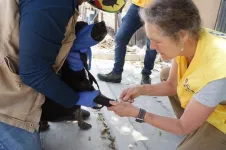(Press-News.org) Researchers studying British Labrador retrievers have identified multiple genes associated with canine obesity and shown that these genes are also associated with obesity in humans.
The dog gene found to be most strongly associated with obesity in Labradors is called DENND1B. Humans also carry the
DENND1B gene, and the researchers found that this gene is also linked with obesity in people.
DENND1B was found to directly affect a brain pathway responsible for regulating the energy balance in the body, called the leptin melanocortin pathway.
An additional four genes associated with canine obesity, but which exert a smaller effect than DENND1B, were also mapped directly onto human genes.
“These genes are not immediately obvious targets for weight-loss drugs, because they control other key biological processes in the body that should not be interfered with. But the results emphasise the importance of fundamental brain pathways in controlling appetite and body weight,” said Alyce McClellan in the University of Cambridge’s Department of Physiology, Development and Neuroscience, and joint first author of the report.
“We found that dogs at high genetic risk of obesity were more interested in food,” said Natalie Wallis in the University of Cambridge’s Department of Physiology, Development and Neuroscience, and joint first author of the report.
She added: “We measured how much dogs pestered their owners for food and whether they were fussy eaters. Dogs at high genetic risk of obesity showed signs of having higher appetite, as has also been shown for people at high genetic risk of obesity.”
The study found that owners who strictly controlled their dogs’ diet and exercise managed to prevent even those with high genetic risk from becoming obese - but much more attention and effort was required.
Similarly, people at high genetic risk of developing obesity will not necessarily become obese, if they follow a strict diet and exercise regime - but they are more prone to weight gain.
As with human obesity, no single gene determined whether the dogs were prone to obesity; the net effect of multiple genetic variants determined whether dogs were at high or low risk.
The results are published today in the journal Science.
“Studying the dogs showed us something really powerful: owners of slim dogs are not morally superior. The same is true of slim people. If you have a high genetic risk of obesity, then when there’s lots of food available you’re prone to overeating and gaining weight unless you put a huge effort into not doing so,” said Dr Eleanor Raffan, a researcher in the University of Cambridge’s Department of Physiology, Development and Neuroscience who led the study.
She added: “By studying dogs we could measure their desire for food separately to the control owners exerted over their dog’s diet and exercise. In human studies, it’s harder to study how genetically driven appetite requires greater willpower to remain slim, as both are affecting the one person.”
The current human obesity epidemic is mirrored by an obesity epidemic in dogs. About 40-60% of pet dogs are overweight or obese, which can lead to a range of health problems.
Dogs are a good model for studying human obesity: they develop obesity through similar environmental influences as humans, and because dogs within any given breed have a high degree of genetic similarity, their genes can be more easily linked to disease.
To get their results, the researchers recruited owners with pet dogs in which they measured body fat, scored ‘greediness’, and took a saliva sample for DNA. Then they analysed the genetics of each dog. By comparing the obesity status of the dog to its DNA, they could identify the genes linked to canine obesity.
Dogs carrying the genetic variant most associated with obesity, DENND1B, had around 8% more body fat than those without it.
The researchers then examined whether the genes they identified were relevant to human obesity. They looked at both large population-based studies, and at cohorts of patients with severe, early onset obesity where single genetic changes are suspected to cause the weight gain.
The researchers say owners can keep their dogs distracted from constant hunger by spreading out each daily food ration, for example by using puzzle feeders or scattering the food around the garden so it takes longer to eat, or by choosing a more satisfying nutrient composition for their pets.
Raffan said: “This work shows how similar dogs are to humans genetically. Studying the dogs meant we had reason to focus on this particular gene, which has led to a big advance in understanding how our own brain controls our eating behaviour and energy use.”
END
Scientists identify genes that make humans and Labradors more likely to become obese
2025-03-06
ELSE PRESS RELEASES FROM THIS DATE:
Early-life gut microbes may protect against diabetes, research in mice suggests
2025-03-06
The microbiome shapes development of insulin-producing cells in infancy, leading to long-term changes in metabolism and diabetes risk, new research in mice has found.
The results could ultimately help doctors reduce the risk of type 1 diabetes—or potentially even restore lost metabolic function in adulthood—by providing specific gut microbes that help the pancreas grow and heal.
The findings are published in Science.
The critical window
Mice that are exposed to broad-spectrum antibiotics in early life have worse metabolic health in the long term, the researchers found. If the mice received antibiotics during a 10-day window shortly after birth, they developed ...
Study raises the possibility of a country without butterflies
2025-03-06
Butterflies are disappearing in the United States. All kinds of them. With a speed scientists call alarming, and they are sounding an alarm.
A sweeping new study published in Science for the first time tallies butterfly data from more than 76,000 surveys across the continental United States. The results: between 2000 and 2020, total butterfly abundance fell by 22% across the 554 species counted. That means that for every five individual butterflies within the contiguous U.S. in the year 2000, there were only four in 2020.
“Action must be taken,” ...
Study reveals obesity gene in dogs that is relevant to human obesity studies
2025-03-06
Dogs are a compelling model of human obesity, in part because they develop obesity due to similar environmental influences as people. In a genome-wide association study (GWAS) of Labrador retrievers, researchers have identified an obesity-related gene – DENND1B – that may also influence obesity in humans. These findings highlight the value of using non-traditional animal models to study complex diseases and highlight the gene’s potential as a target for future obesity research across species. Obesity is a ...
A rapid decline in US butterfly populations
2025-03-06
Butterfly populations across the United States are in alarming decline, according to a new study, with total abundance falling by 22% in just 20 years. Such widespread and worrisome losses portend broader environmental threats and emphasize the urgent need for conservation action. “Our national-scale findings paint the most complete – and concerning – picture of the status of butterflies across the country in the early 21st century,” write the authors. The decline of biodiversity has been extensively documented worldwide. Among these losses, the decline of insects is particularly ...
Indigenous farming practices have shaped manioc’s genetic diversity for millennia
2025-03-06
A new genomic study reveals how Indigenous traditional farming practices have shaped the evolution of manioc – one of the world’s most important staple crops – for the better. The domestication of plants and the rise of agriculture were transformative events in human history. Today, a few staple crops provide most human calories, including manioc (cassava or yuca), a vital root crop that sustains nearly a billion people across the tropics. Although it ranks as the world’s seventh most significant crop, manioc is primarily cultivated on small farms. The plant’s ...
Controlling electrons in molecules at ultrafast timescales
2025-03-06
Scientists at YOKOHAMA National University, in collaboration with RIKEN and other institutions in Japan and Korea, have made an important discovery about how electrons move and behave in molecules. This discovery could potentially lead to advances in electronics, energy transfer, and chemical reactions. Published in the Journal, Science, their study reveals a new way to control the distribution of electrons in molecules using very fast phase-controlled pulses of light in the terahertz range.
Atoms and molecules contain negatively charged electrons that usually stay in specific energy levels, like layers, ...
Tropical forests in the Americas are struggling to keep pace with climate change
2025-03-06
Embargoed until 14:00 US Eastern Time, Thursday 6 March 2025
Tropical forests in the Americas are struggling to keep pace with climate change
Tropical rainforests play a vital role in global climate regulation and biodiversity conservation. However, a major new study published in Science reveals that forests across the Americas are not adapting quickly enough to keep pace with climate change, raising concerns about their long-term resilience.
The research, led by Dr. Jesús Aguirre-Gutiérrez from the University of Oxford’s Environmental Change Institute (ECI), involved over 100 scientists ...
Brain mapping unlocks key Alzheimer’s insights
2025-03-06
Researchers from The University of Texas at Arlington and the University of California–San Francisco have used a new brain-mapping technique to identify memory-related brain cells vulnerable to protein buildup, a key factor in the development of Alzheimer’s disease, an incurable, progressive brain disorder that slowly destroys memory and thinking skills.
In Texas, nearly half a million people live with Alzheimer’s disease, a form of dementia that costs the state approximately $24 billion in caregiver time, according to the Texas Department of State Health Services. Texas ranks fourth in the nation for Alzheimer’s cases ...
Clinical trial tests novel stem-cell treatment for Parkinson’s disease
2025-03-06
A recently launched Phase 1 clinical trial at Mass General Brigham is examining the safety and feasibility of a groundbreaking treatment approach for Parkinson’s disease in which a patient’s stem cells are reprogrammed to replace dopamine cells in the brain damaged by the disease. The first-of-its-kind trial of an autologous stem cell transplant, based on research and technologies invented and validated preclinically at McLean Hospital’s Neuroregeneration Research Institute (NRI), has enrolled and treated three patients at Brigham and Women’s ...
Awareness of rocky mountain spotted fever saves lives
2025-03-06
Rocky Mountain spotted fever is a bacterial infection spread by biting ticks to humans and dogs. Found on every continent except Antarctica, the infectious disease has been spreading since the early 2000s, most notably in Mexico and Brazil. Of the cases reported, more than half of infected people and dogs die.
A paper led by the University of California, Davis, highlights one of the most effective but often missing solutions to surviving this preventable, deadly disease: awareness. Most fatal cases stem from delays in diagnosis and treatment.
“The No. 1 thing that prevents human death from Rocky Mountain spotted fever is for everyone at high risk to know ...







